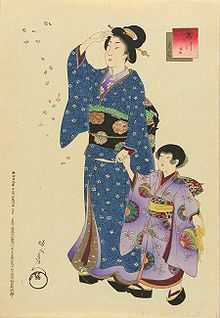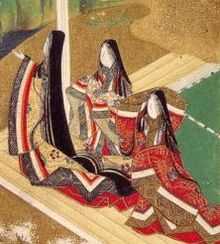Furisode
A furisode (振袖, lit. swinging sleeves) is a style of kimono distinguishable by its long sleeves, which range in length from 85 centimeters for a kofurisode (小振袖) to 114 centimeters for an ōfurisode (大振袖). The sleeves are attached to the body of the kimono only for a short distance; the inner edge is open for the rest of its length, allowing the lining to show on the inner edge (or both, if the sleeve is left open on the outer edge as well).
Furisode are the most formal style of kimono worn by unmarried women in Japan.
The furisode is made of very fine, brightly colored silk, and is commonly rented or bought by parents for their daughters to wear when celebrating Coming of Age Day the year they turn 20. By wearing a furisode, a young woman signifies that she is both single and a legal adult, and thus available for marriage. In this sense, a furisode might be likened to the formal gowns worn by debutantes in the West.
The furisode is generally worn for formal social functions such as the tea ceremony or wedding ceremonies of relatives. Since furisodes can be quite expensive, many women rent them as needed rather than purchasing them.
History

The furisode originated in the mid-1500s as middle- and upper-class children's clothing for both sexes; it was not worn by adults. Initially furisode had relatively short sleeves and was used as everyday wear by those who could afford to do so; over time as the sleeves became more exaggerated it became an elegant form of dress worn mainly on special occasions. According a 17th-century text, boys could wear furisode until their 18th year or until they went through their coming-of-age ceremony (which usually occurred in late adolescence), while girls were supposed to cease wearing it upon marriage or reaching their 20th year.[1] Initially furisode did not differ noticeably between the sexes, but fabric designs started to become more gendered in the 19th century.[2] In the 20th century furisode became restricted to women and girls only, as part of the increasing gender-specificity of children's clothing that developed in the wake of Western influence. As the furisode became increasingly associated with young adult women, the term was removed from the shorter-sleeved children's garment, which acquired the more generic term wakiake (open-sided).
References
- ↑ Nagasaki, Iwao (1994). Furisode. Kyoto: Fujioka Mamoru. p. 93.
- ↑ Sawada, Kazuto. "Furisode and teenage boys". Bimonthly Magazine "REKIHAKU". National Museum of Japanese History. Retrieved 9 May 2014.
| Wikimedia Commons has media related to Furisode. |
| ||||||||||||||||
